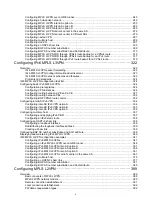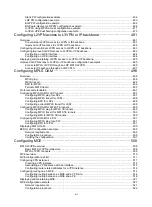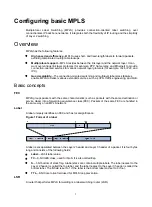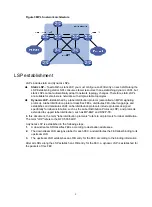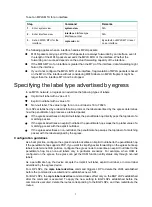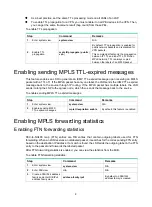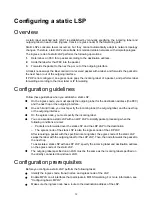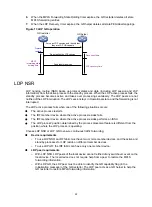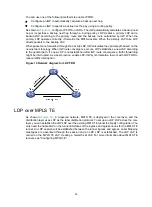
9
•
As a best practice, set the same TTL processing mode on all LSRs of an LSP.
•
To enable TTL propagation for a VPN, you must enable it on all PE devices in the VPN. Then,
you can get the same traceroute result (hop count) from those PEs.
To enable TTL propagation:
Step Command
Remarks
1.
Enter system view.
system-view
N/A
2.
Enable TTL
propagation.
mpls ttl propagate
{
public
|
vpn
}
By default, TTL propagation is enabled for
public network packets and is disabled for
VPN packets.
This command affects only the propagation
between IP TTL and label TTL. Within an
MPLS network, TTL is always copied
between the labels of an MPLS packet.
Enabling sending MPLS TTL-expired messages
This feature enables an LSR to generate an ICMP TTL-expired message upon receiving an MPLS
packet with a TTL of 1. If the MPLS packet has only one label, the LSR sends the ICMP TTL-expired
message back to the source through IP routing. If the MPLS packet has multiple labels, the LSR
sends it along the LSP to the egress node, which then sends the message back to the source.
To enable sending MPLS TTL-expired messages:
Step Command
Remarks
1.
Enter system view.
system-view
N/A
2.
Enable sending MPLS
TTL-expired messages.
mpls ttl expiration enable
By default, this feature is enabled.
Enabling MPLS forwarding statistics
Enabling FTN forwarding statistics
FEC-to-NHLFE map (FTN) entries are FIB entries that contain outgoing labels used for FTN
forwarding. When an LSR receives an unlabeled packet, it searches for the corresponding FTN entry
based on the destination IP address. If a match is found, the LSR adds the outgoing label in the FTN
entry to the packet and forwards the labeled packet.
After FTN forwarding statistics is enabled, you can view the statistics from the MIB.
To enable FTN forwarding statistics:
Step Command Remarks
1.
Enter system view.
system-view
N/A
2.
Enter RIB view.
rib
N/A
3.
Create a RIB IPv4 address
family and enter RIB IPv4
address family view.
address-family ipv4
By default, no RIB IPv4
address family is created.



